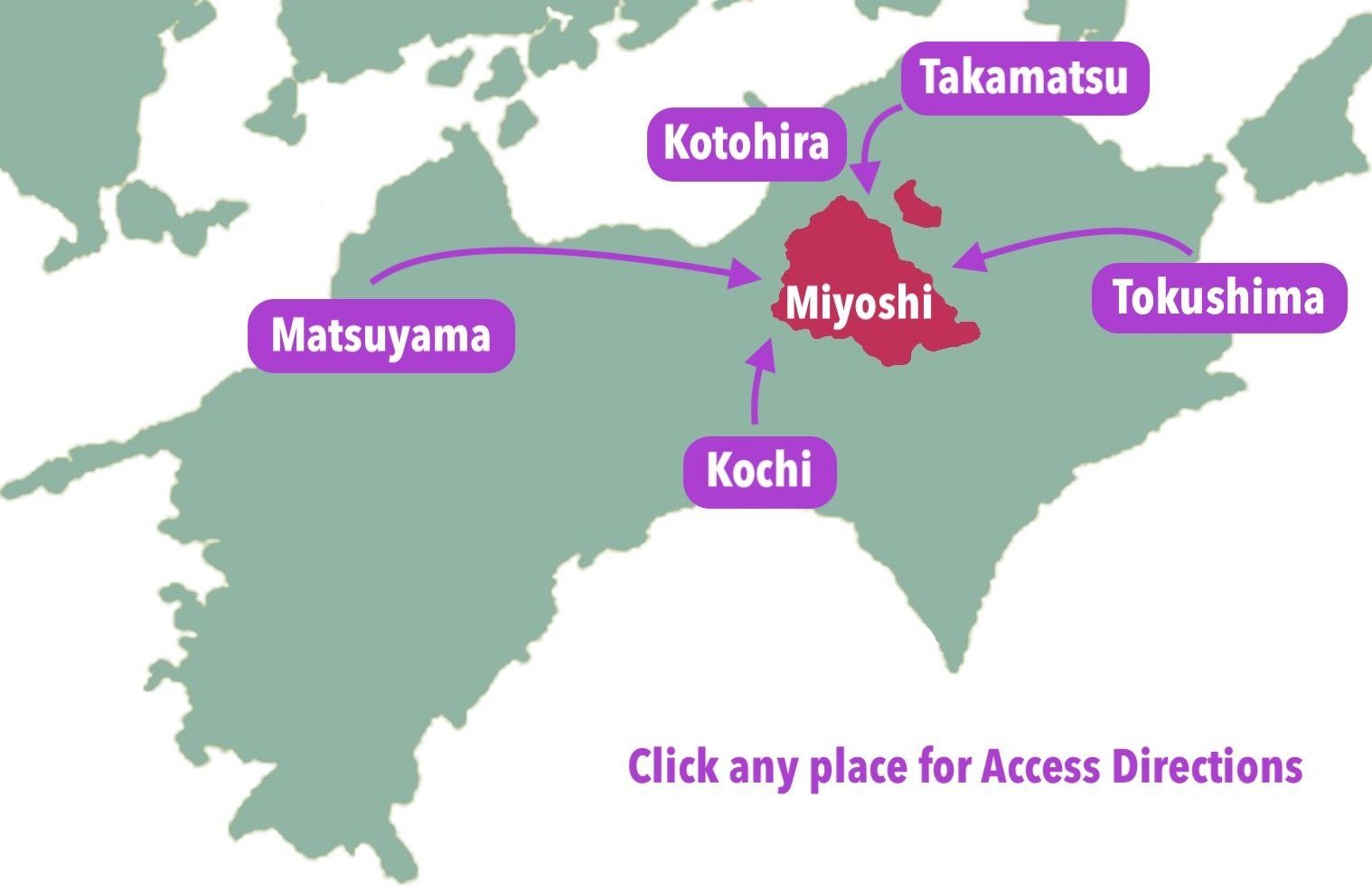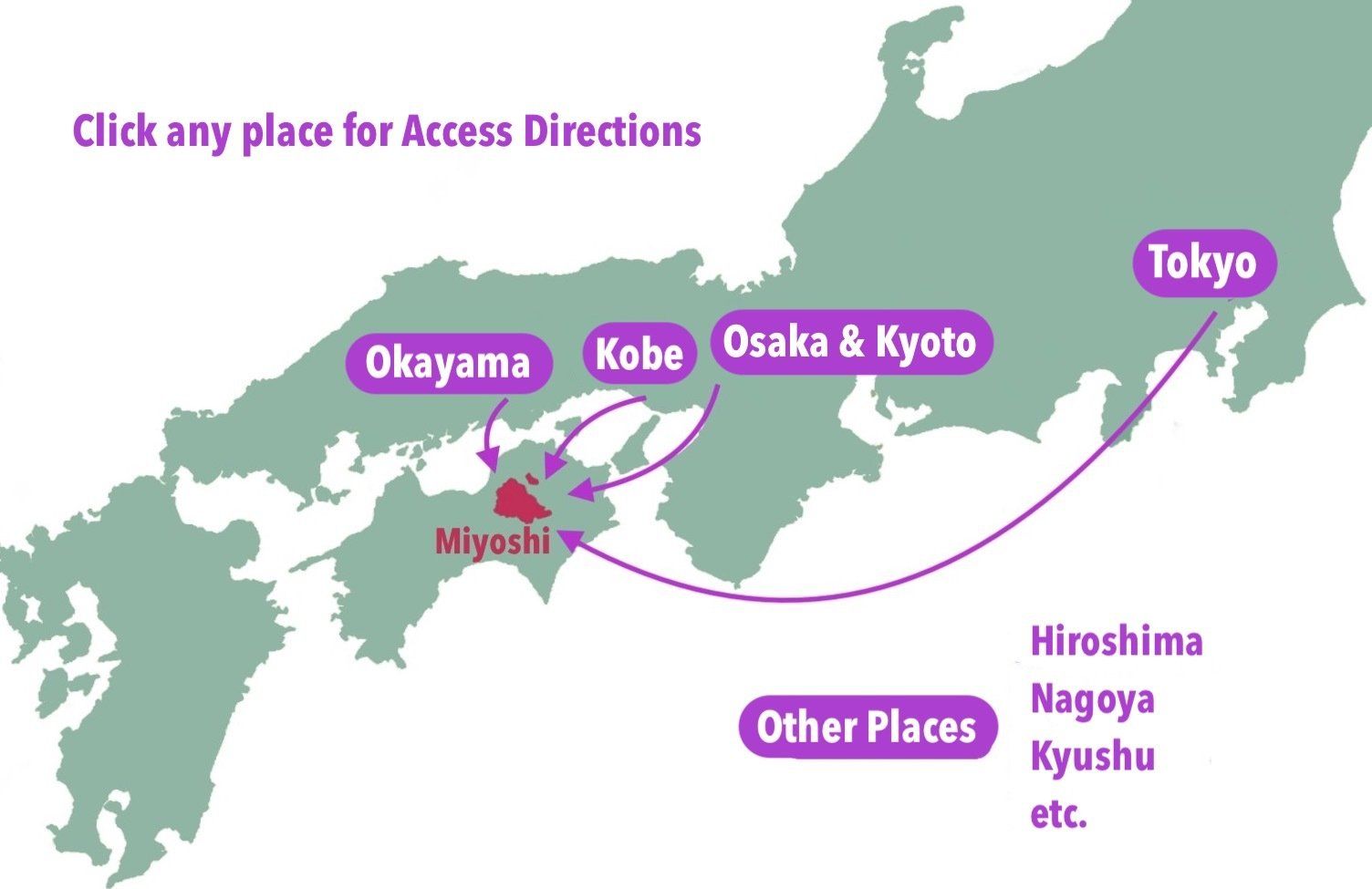Transport
Getting here and getting around


Shikoku Trains & Rail Passes
A unique Luxury Train between Kotohira and Oboke



Luxuriously outfitted, the ride includes a snazzy (yet smallish) lunch box, comfy seats, and special viewing windows. Beer, local sake, and other soft drinks are also available. The 2 hour trip departs Kotohira at 10:48am (from Tadotsu at 10:18), and costs about ¥10,000** (including meals). Internet-made reservations of at least 10 days needed, but bookings are accepted no more than 30 days in advance.
**IyaTime Tip: It is also possible to take the Sennan Monogatari train without meals for only about ¥3600 (the extra ¥5500 for meals is actually optional). Also, you can take this train from Oboke (departing at 14:21) up to Kotohira or Tadotsu instead and a different optional lunch box is served for ¥4500 extra.
However, JR only offers internet reservations in English with the lunch box included.
And since JR usually does not take direct internet reservations for any train in the country, they also charge a handling fee of ¥870 when booking this on the internet. (Oddly, internet bookings are not available on the Japanese website)
So if you want to book without the meals, or to simply not pay the handling fee, then you have to either call them to make reservations, or purchase tickets in person at the Green Window of any major train station (tickets can be bought from 30 days before up to the day of departue these ways, but for any meal requires a 4 day advance booking).
Also, people with an All Shikoku Rail Pass can get a free base fare for this train, but will still need to pay for a reserved express seat and Green Car fees, totalling about ¥2400 (but reserving this way needs to be done in person with an already valid pass).
You can find their phone number on their Japanese website
(they probably only speak Japanese on the phone, but should have English speakers at the Green Window in places like Osaka, Kyoto, Tokyo, etc.)
Ganbatte !!

There are several availability length options from 3 days (for about ¥9000) up to 7 days (for about ¥12,000) and it covers all the JR rail lines in Shikoku as well as all the private lines and trams. You can even use it for the ferry from Takamatsu to Shodoshima and with the Olive Bus that goes around the island.
There are lots of other perks that come with the rail pass (check their website to see the specifics, including their FAQs page) including:
- Several ferries to/from Shikoku offer good discounts with this Rail Pass, with some even maintaining the availability for several days or weeks after the pass has expired;
- Some JR bus lines give a discount with the pass;
- You can even ride the big ferris wheel that sits atop the Iyotetsu Building in Matsuyama for free!
Are you or someone in your group traveling in Shikoku during your birthday month? Well, even though the ALL SHIKOKU Rail Pass is a bit better deal, this special ticket is about the same price for the 3 day plan and is also available to resident foreigners and Japanese , not just foreign tourists.
Its costs ¥9500 for unreserved seats (or ¥13,000 for Green car or reserved seats) and is good for 3 consecutive days, but it can only be bought and used within your birthday month (proof of birthday obviously required). However you can also travel with up to three other people with them also paying the same price. Pretty sweet!
Its valid on all JR Shikoku trains as well as most private lines (but not the city tram lines), as well as some JR buses. You can also use it to get a pretty good discount for JR Eki Rental cars, but this could be a bit hard to figure out without understanding some Japanese.
You can buy the Birthday Kippu at most staffed stations in Shikoku with either Green Windows of Warp Branches.
You'll need to travel a fair amount to get your money's worth with this somewhat ironically named "Free" ticket. Good for 3 consecutive days, its more or less the same as the Birthday Kippu but valid anytime of the year and costs ¥16,140.
Its available across Shikoku just like the B-day Kippu, but before buying do an evaluation of your travel plans and see if its worth getting compared to simply buying the standard fare tickets.
There are lots of ways to get around in Miyoshi. We list below options for traveling by Car & Bicycle (and getting rental cars), by Train , by Public Bus , by Taxi (with taxi touring courses available), and even by Walking and Hitchhiking.
Even though driving is a good way to get around since it offers more flexibility, be sure to realize that the narrow, curvy mountain roads of the Iya Valley are not for everybody, and even experienced drivers can have trouble. We give some good tips on what to expect and how to handle the roads here, so please read this before deciding to come by car.
Trains may be good for getting to the Miyoshi area from the rest of Japan (see "Transport To & From Miyoshi" above) but only the main sights in Oboke & Koboke and in Ikeda are accessible by train. To go anywhere in the Iya Valley, you'll need to either take a
bus or
taxi (see below).
To get around in the Iya Valley via public transport would mean using a
bus. Local buses connect Iya to Oboke and to Ikeda as well as to a few other points outside Miyoshi. The bus system is pretty extensive (and a bit confusing) and we have tried to explain how to navigate it. However, do realize that buses into Oku-Iya* can be pretty infrequent.
Oku-Iya Seasonal Buses
*The main Shikoku Kotsu Buses to/from Ikeda, Oboke, and Nishi-Iya have their final/first stop in Oku-Iya at Kubo . To access the deepest points of Oku-Iya, it is necessary to transfer to the Local Municipal Buses. These local buses operate everyday on the route going from Kubo to Nagoro (Scarecrow Village). But beyond Nagoro to Niju Kazurabashi (Double Vine Bridges) and to Tsurugisan (Minokoshi) these buses operate on seasonal schedules that may not be every day.
- Also, there are a few other seasonal buses linking the final stop in Oku-Iya (Tsurugisan Bus Stop at Minokoshi) with the neighboring towns and their train stations. See how and when to go below:
For Nagoro (Scarecrow Village), Niju Kazurabashi (Dbl Vine Bridge), and Tsurugisan (Minokoshi)
The schedules and operating date calendar for these buses can be found on the Bus Timetable page
To see these places on the map along with this explanation, please check Inside Miyoshi by Bus (Oku-Iya)JR Sadamitsu Station (Tsurugi Town) to Tsurugisan (Minokoshi)
The schedules and operating date calendar for these buses can be found on the Bus Timetable page
To see these places on the map along with this explanation, please check Tokushima by BusThe schedules and operating date calendar for these buses can be found on the Bus Timetable page
To see these places on the map along with this explanation, please check Tokushima by BusIf you are not interested in taking your chances with driving yourself or waiting around for the often infrequent buses, choose to take a
taxi
instead. There are several taxi companies that offer point-to-point metered service, as well as hourly rates and different
touring course options, with some offering English speaking guides.
Travel by Walking & Hitchhiking
To really take the place in, hit the pavement with your feet. We explain some good places to walk as well as how to try hitching a ride.
Discover Tokushima
Find out more about the rest of Tokushima Prefecture, including Tokushima City, the Naruto Whirlpools, and the Anan Coastline.
Hike Master Japan
Discover different awesome hikes located elsewhere in Shikoku as well as the rest of Japan, with lots of detailed trail info, route maps, and excellent photographs.
Shikoku Tours
Shikoku Island is one of the most fascinating places in Japan, and Shikoku Tours offers detailed insight and wonderful touring options for discovering this largely unexplored region.
japan-guide.com
Probably the most comprehensive resource for traveling all around Japan. Detailed info and lots of great articles.
Japan National Tourism Organization
Learn about what the rest of Japan has to offer. The JNTO site gives a good overview of everwhere in the country.





